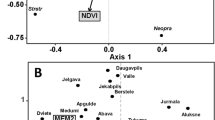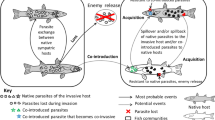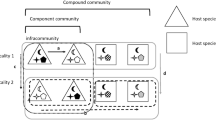Abstract
Interest in the ecology of parasite communities has increased over the last decade. The increase in attention appears to reflect a shift in emphasis away from descriptive studies toward more quantitative approaches identifying processes responsible for creating community patterns. Recognition of three general features of parasite communities have contributed to the change in focus. First, helminth communities have discrete boundaries with each host individual representing replicate communities for statistical analysis of patterns. Second, by distinguishing either between different guilds (sensu Root, 1973) or among dominant or rare species (core/satellite or centrifugal species: Hanski, 1982; Rosenzweig and Abramsky, 1986), structure within a restricted group of species may be more apparent than for the community as a whole. Finally, communities of specialist organisms, such as parasites, might be structured in fundamentally different ways from generalist organisms (Price, 1980, 1984a).
Access this chapter
Tax calculation will be finalised at checkout
Purchases are for personal use only
Preview
Unable to display preview. Download preview PDF.
Similar content being viewed by others
References
Alford, R. A. (1986) Habitat use and positional behavior of Anuran larvae in a Northern Florida temporary pond. Copeia, 1986, 408–23.
Anderson, R.C. (1984) The origins of zooparasitic nematodes. Can. J. Zool., 62, 317–28.
Avery, H. W. (1987) Roles of Diet Protein and Temperature in the Nutritional Energetics of Juvenile Slider Turtles, Trachemys scripta. M.S. Thesis, State University College at Buffalo, Buffalo, NY.
Avery, R. A. (1971) Helminth parasite populations in newts and their tadpoles. Freshwater Biology, 1, 113–19.
Baker, M. (1984) Nematode parasitism in amphibians and reptiles. Can. J. Zool., 62, 747–57.
Behler, J. L. and King, F. W. (1979) The Audubon Society Field Guide to North American Reptiles and Amphibians, Alfred A. Knopf, Inc., New York.
Benes, E. S. (1985) Helminth parasitism in some central Arizona lizards. Southwest. Nat., 30, 467–73.
Bohnsack, J. A. and Talbot, F. H. (1980) Species packing by reef fishes on Australian and Caribbean reefs: an experimental approach. Bull. Marine Sci., 30, 710–23.
Brandt, B. B. (1936) Parasites of certain North Carolina Salientia. Ecol. Monogr., 6, 491–532.
Brooks, D. R. (1979a) Testing the context and extent of host—parasite coevolution. Syst. Zool., 28, 299–307.
Brooks, D. R. (1979b) Testing hypotheses of evolutionary relationships among parasites: the digeneans of crocodilians. Am. Zool., 19, 1225–38.
Brooks, D.R. (1980) Allopatric speciation and non-interactive parasite community structure. Syst. Zool., 29, 192–203.
Brooks, D. R. (1981a) Raw similarity measures of shared parasites: an empirical tool for determining host phylogenetic relationships? Syst. Zool., 30, 203–7.
Brooks, D. R. (1981b) Hennig’s parasitological method: a proposed solution. Syst. Zool., 30, 229–49.
Bundy, D. A. P., Vogel, P. and Harris, E. A. (1987) Helminth parasites of Jamaican anoles (Reptilia: Iguanidae): a comparison of the helminth fauna of 6 Anolis species. J. Helminth., 61, 77–83.
Bush, A. O. and Holmes, J. C. (1986) Intestinal helminths of lesser scaup ducks: an interactive community. Can. J. Zool., 64, 142–52.
Campbell, R. A. (1968) A comparative study of the parasites of certain Salientia from Pocahontas State Park, Virginia. Virginia J. Sci., 19, 13–20.
Chabaud, A. G. (1981) Host range and evolution of nematode parasites of vertebrates. Parasitology, 82, 169–70.
Coggins, J. R. and Sajdak, R. A. (1982) A survey of helminth parasites in the salamanders and certain anurans from Wisconsin. Proc. Helminthol. Soc. Wash., 49, 99–102.
Collins, R. F. (1969) The helminths of Natrix, spp. and Agkistrodon piscivorous piscivorous (Reptilia: Ophidia) in Eastern North Carolina. J. Elisha Mitchell Sci. Soc., 85, 141–4.
Conant, R. (1975) A Field Guide to Reptiles and Amphibians of Eastern and Central North America, Houghton Mifflin Co., Boston.
Connell, J. H. (1980) Diversity and the coevolution of competitors, or the ghost of competition past. Oikos, 35, 131–8.
Connell, J. H. (1983) On the prevalence and relative importance of interspecific competition: evidence from field experiments. Am. Nat., 122, 661–96.
Connell, J. H. (1985) The consequences of variation in initial settlement vs. post-settlement mortality in rocky intertidal communities. J. Exp. Marine Biol. Ecol., 93, 11–45.
Connor, E. F. and McCoy, E. D. (1979) The statistics and biology of the species-area relationship. Am. Nat., 113, 791–833.
Cornell, H. V. (1985) Local and regional richness of cynipine gall wasps on California oaks. Ecology, 66, 1247–60.
Crawford, K. M., Spotila, J. R. and Standora, E. A. (1983) Operative environmental temperature and basking behavior of the turtle, Pseudemys scripta. Ecology, 64, 989–99.
Crompton, D. W. T. and Nesheim, M. C. (1976) Host-parasite relationships in the alimentary tract of domestic birds. Adv. Parasitol., 14, 95–194.
Detterline, J. L., Jacob, J. S. and Wilhelm, W. E. (1984) A comparison of helminth endoparasites in the cottonmouth (Agkistrodon piscivorous) and three species of water snakes (Nerodia). Trans. Am. Microsc. Soc., 103, 137–43.
Dogiel, V. A. (1964) General Parasitology, Oliver and Boyd, Edinburgh and London.
Dronen, N. O., Jr (1978) Host—parasite population dynamics of Haematoloechus coloradensis Cort, 1915 (Digenea: Plagiorchidae). Am. Midl. Nat., 99, 330–49.
Dubinina, M. N. (1949) Ecological studies on the parasite fauna of Testudo horsefeldi Grau in Tadzhikistan (in Russian). Parazit. Sbornik, 11, 61–97.
Duellmann, W. E. and Trueb, L. (1986) Biology of Amphibians, McGraw-Hill Book Company, New York.
Dunbar, J. R. and Moore, J. D. (1979) Correlations of host specificity with host habitat in helminths parasitizing the plethodontids of Washington County, Tennessee. J. Tenn. Acad. Sci., 54, 106–9.
Dunham, A. E. (1981) Populations in a fluctuating environment: the comparative population ecology of the iguanid lizards Sceloporus merriamia and Urosaurus ornatus. Misc. Publ. Mus. Zool., Univer. Michigan, 158, 1–62.
Dyer, W. G., Brandon, R. A. and Price, R. L. (1980) Gastrointestinal helminths in relation to sex and age of Desmognathus fuscus (Green, 1818) from Illinois. Proc. Helminthol. Soc. Wash., 47, 95–9.
Ernst, C. H. and Ernst, E. M. (1980) Relationships between North American turtles of the Chrysemys complex as indicated by their endoparasitic helminths. Proc. Biol. Soc. Wash., 93, 339–45.
Esch, G. W. and Gibbons, J. W. (1967) Seasonal incidence of parasitism in the painted turtle, Chrysemys picta marginata Agassiz. J. Parasitol., 53, 818–21.
Esch, G.W., Gibbons, J. W. and Bourque, J. E. (1975) An analysis of the relationship between stress and parasitism. Am. Midl. Nat., 93, 339–53.
Esch, G. W., Gibbons, J. W. and Bourque, J. E. (1979a) The distribution and abundance of enteric helminths in Chrysemys s. scripta from various habitats on the Savannah River plant in South Carolina. J. Parasitol., 65, 624–32.
Esch, G. W., Gibbons, J. W. and Bourque, J. E. (1979b) Species diversity of helminth parasites in Chrysemys s. scripta from a variety of habitats in South Carolina. J. Parasitol., 65, 633–8.
Feder, M. E. (1983) Integrating the ecology and physiology of plethodontid salamanders. Herpetologica, 39, 291–310.
Feder, M. E. and Lynch, J. F. (1982) Effects of latitude, season, elevation, and microhabitat on field body temperatures of neotropical and temperate zone salamanders. Ecology, 63, 1657–64.
Fischthal, J. H. (1955a) Helminths of salamanders from Promised Land State Forest Park, Pennsylvania. Proc. Helminthol. Soc. Wash., 22, 46–9.
Fischthal, J. H. (1955b) Ecology of worm parasites in South-Central New York salamanders. Am. Midl. Nat., 53, 176–83.
Fowler, S. V. and Lawton, J. H. (1982) The effects of host-plant and local abundance on the species richness of agromyzid flies attacking British umbellifers. Ecol. Entomol., 7, 257–65.
Freeland, W. J. (1979) Primate social groups as biological islands. Ecology, 60, 719–28.
Gaines, S., Brown, S. and Roughgarden, J. (1985) Spatial variation in larval concentrations as a cause of spatial variation in settlement for the barnacle, Balanus glandula. Oceologia, 67, 267–72.
Gibbons, J. W. and Semlitsch, R. D. (1986) Activity patterns. In Snakes: Ecology and Evolutionary Biology, (eds, R. A. Seigel, J. T. Collins and S. S. Novak), Macmillan Co., New York, pp. 396–421.
Goater, T. M., Esch, G. W. and Bush, A. O. (1987) Helminth parasites of sympatric salamanders ecological concepts at infracommunity, component, and compound community levels. Am. Midl. Nat., 118, 289–300.
Grant, B. W. and Dunham, A. E. (1988) Thermally imposed time constraints on the activity of the desert lizard Sceloporus merriami. Ecology, 69, 167–76.
Hadley, N. F. and Szarek, S. R. (1981) Productivity of desert ecosystems. Biol. Sci., 31, 747–53.
Hanski, I. (1982) Dynamics of regional distribution: the core and satellite species hypothesis. Oikos, 38, 210–21.
Hardin, E. L. and Janovy, J., Jr (1988) Population dynamics of Distoichometra bufonis (Cestoda: Nematotaeniidae) in Bufo woodhousii. J. Parasitol., 74, 360–65.
Harwood, P. D. (1932) The helminths parasitic in the Amphibia and Reptilia of Houston, Texas, and vicinity. Proc. U.S. Nat. Museum, 18, 1–77.
Holmes, J. C. (1983) Evolutionary relationships between parasitic helminths and their hosts. In Coevolution, (eds, D. J. Futuyma and M. Slatkin), Sinauer Associates, Sunderland, MA, pp. 161–85.
Holmes, J. C. (1987) The structure of helminth communities. Intern. J. Parasitol., 17, 203–8.
Holmes, J. C. and Price, P. W. (1980) Parasite communities: the roles of phylogeny and ecology. Syst. Zool., 29, 203–13.
Holmes, J. C. and Price, P. W. (1986) Communities of parasites. In Community Ecology: Pattern and Process, (eds, D.J. Anderson and J. Kikkawa), Blackwell Scientific Publications, Oxford, UK, pp. 187–213.
Huey, R. B. (1982) Temperature, physiology, and the ecology of reptiles. In Biology of the Reptilia, vol. 12, (eds, C. Gans and F. H. Pough), Academic Press, New York, pp. 25–91.
Huey, R.B. and Pianka, E. R. (1981) Ecological consequences of foraging mode. Ecology, 62, 991–9.
Jackson, T. and Beaudoin, R. L. (1967) Comparison of the parasite fauna in two metamorphic stages of the red-spotted newt Notophthalmus viridescens viridescens. Proc. Pa. Acad. Sci., 40, 70–75.
Jacobson, K. C. (1987) Infracommunity Structure of Enteric Helminths in the Yellow-bellied Slider Trachemys scripta scripta. M.S. Thesis, Wake Forest University, Winston-Salem, NC. 46 pp.
Jarroll, E. L., Jr (1980) Population dynamics of Bothriocephalus rarus (Cestoda) in Notophthalmus viridescens. Am. Midl. Nat., 103, 360–66.
Kennedy, C. R. (1978) An analysis of the metazoan parasitocoenoses of brown trout Salmo trutta from British Lakes. J. Fish Biol., 13, 255–63.
Kennedy, C. R., Bush, A. O. and Aho, J. M. (1986) Patterns in helminth communities: why are birds and fish different? Parasitology, 93, 205–15.
Kuris, A. M., Blaustein, A. R. and Alió, J. J. (1980) Hosts as islands. Am. Nat., 116, 570–86.
Landewe, J. E. (1963) Helminth and Arthropod Parasites of Salamanders from Southern Illinois. M.S. Thesis, Southern Illinois University, Carbondale, IL. 47 pp.
Lawton, J. H. (1982) Vacant niches and unsaturated communities: a comparison of bracken herbivores at 2 sites on 2 continents. J. Anim. Ecol., 51, 573–95.
Lawton, J. H., Cornell, H., Dritschilo, W. and Hendrix, S. D. (1981) Species as islands: comments on a paper by Kuris et al. Am. Nat., 117, 623–7.
Lawton, J. H. and Strong, D. R. (1981) Community patterns and competition in folivorous insects. Amer. Nat., 118, 317–38.
Likens, G. E. (1983) A priority for ecological research. Bull. Ecol. Soc. America, 64, 234–43.
Limsuwan, C. and Dunn, M. C. (1978) A survey of helminth parasites from turtles in Rutherford County, Tennessee. J. Tenn. Acad. Sci., 53, 111–14.
MacArthur, R. H. and Wilson, E. O. (1967) The Theory of Island Biogeography, Princeton University Press, Princeton, NJ.
Martin, D. R. (1972) Distribution of helminth parasites in turtles native to Southern Illinois. Trans. Ill. Acad. Sci., 65, 61–7.
Pearce, R. C. and Tanner, W. W. (1973) Helminths of Sceloporus lizards in the Great Basin and Upper Colorado Plateau of Utah. Great Basin Nat., 33, 1–18.
Pianka, E. R. (1986) Ecology and Natural History of Desert Lizards, Princeton University Press, Princeton, NJ.
Piatt, T. R. (1977) A survey of the helminth fauna of two turtle species from Northwestern Ohio. Ohio J. Sci., 77, 97–8.
Price, P. W. (1980) Evolutionary Biology of Parasites, Princeton University Press, Princeton, NJ.
Price, P. W. (1984a) Communities of specialists: vacant niches in ecological and evolutionary time. In Ecological Communities: Conceptual Issues and the Evidence, (eds, D. R. Strong, D. S. Simberloff, L. Abele and A. B. Thistle), Princeton University Press, Princeton, NJ, pp. 510–23.
Price, P. W. (1984b) Alternative paradigms in community ecology. In A New Ecology: Novel Approaches to Interactive Systems, (eds, P. W. Price, C. N. Slobodchikoff and W. S. Gaud), John Wiley and Sons, New York, pp. 353–83.
Price, P. W. and Clancy, K. M. (1983) Patterns in number of helminth parasite species in freshwater fishes. J. Parasitol., 69, 449–54.
Price, R. L. and Buttner, J. K. (1982) Gastrointestinal helminths of the central newt, Notophthalmus viridescens louisianensis Wolterstorff, from Southern Illinois.Proc. Helminthol. Soc. Wash., 49, 285–8.
Rankin, J. S. (1937) An ecological study of parasites of some North Carolina salamanders. Ecol. Monogr., 7, 169–269.
Rankin, J. S. (1945) An ecological study of the helminth parasites of amphibians and reptiles of Western Massachusetts and vicinity. J. Parasitol., 31, 142–50.
Rau, M. E. and Gordon, D. M. (1978) Overwintering of helminths in the Garter snake (Thamnophis sirtalis sirtalis). Can. J. Zool., 56, 1765–7.
Rau, M. E. and Gordon, D. M. (1980) Host specificity among the helminth parasites of four species of snakes. Can. J. Zool., 58, 929–30.
Rausch, R. (1947) Observations on some helminths parasitic in Ohio turtles. Am. Midl. Nat., 38, 434–42.
Ricklefs, R. E. (1987) Community diversity: relative roles of local and regional processes. Science, 235, 167–71.
Rohde, K. (1979) A critical evaluation of intrinsic and extrinsic factors responsible for niche restriction in parasites. Am. Nat., 114, 648–71.
Root, R. B. (1973) Organization of a plant-arthropod association in simple and diverse habitats: the fauna of collards (Brassica oleracea). Ecol. Monogr., 43, 95–124.
Rosenzweig, M. and Abramsky, Z. (1986) Centrifugal community organization. Oikos, 46, 339–48.
Salt, G. W. (1982) Ecology and Evolutionary Biology: A Round Table on Research, University of Chicago Press, Chicago.
Schad, G. A. (1963) Niche diversification in a parasitic species flock. Nature, 198, 404–6.
Schiebe, J. S. (1987) Climate, competition, and the structure of temperate zone lizard communities. Ecology, 68, 1424–36.
Schoener, T. W. (1974) Resource partitioning in ecological communities. Science, 185, 27–39.
Schoener, T. W. (1983) Field experiments on interspecific competition. Am. Nat., 122, 240–85.
Seigel, R. (1986) The Foraging Ecology and Resource Partitioning Patterns of Two Species of Garter Snakes. PhD Dissertation, University of Kansas, Lawrence, U.S.A.
Sokal, R. R. and Rohlf, F. J. (1981) Biometry, W. H. Freeman and Company, San Francisco.
Stock, T. M. and Holmes, J. C. (1987) Host specificity and exchange of intestinal helminths among four species of grebes (Podicipedidae). Can. J. Zool., 65, 669–76.
Stock, T. M. and Holmes, J. C. (1988) Functional relationships and microhabitat distributions of enteric helminths of grebes (Podicipedidae): the evidence for interactive communities. J. Parasitol., 74, 214–27.
Strong, D. R., Lawton, J. H. and Southwood, T. R. E. (1984) Insects on Plants: Community Patterns and Mechanisms, Blackwell Scientific Publishers, Oxford.
Telford, S. R., Jr (1970) A comparative study of endoparasitism among some Southern California lizard populations. Am. Midl. Nat., 83, 516–54.
Terborgh, J. W. and Faaborg, J. (1980) Saturation of bird communities in the West Indies. Am. Nat., 116, 178–95.
Toft, C. A. (1981) Feeding ecology of Panamanian Litter Anurans: patterns in diet and foraging mode. J. Herpetol., 15, 139–44.
Toft, C. A. (1985) Resource partitioning in amphibians and reptiles. Copeia, 1985, 1–21.
Vogel, P. and Bundy, D. A. P. (1987) Helminth parasites of Jamaican anoles (Reptilia: Iguanidae): variation in prevalence and intensity with host age and sex in a population of Anolis lineatopus. Parasitology, 94, 399–404.
Wilbur, H. M. (1987) Regulation of structure in complex systems: experimental temporary pond communities. Ecology, 68, 1437–52.
Editor information
Editors and Affiliations
Rights and permissions
Copyright information
© 1990 Chapman and Hall
About this chapter
Cite this chapter
Aho, J.M. (1990). Helminth communities of amphibians and reptiles: comparative approaches to understanding patterns and processes. In: Esch, G.W., Bush, A.O., Aho, J.M. (eds) Parasite Communities: Patterns and Processes. Springer, Dordrecht. https://doi.org/10.1007/978-94-009-0837-6_7
Download citation
DOI: https://doi.org/10.1007/978-94-009-0837-6_7
Publisher Name: Springer, Dordrecht
Print ISBN: 978-94-010-6863-5
Online ISBN: 978-94-009-0837-6
eBook Packages: Springer Book Archive




